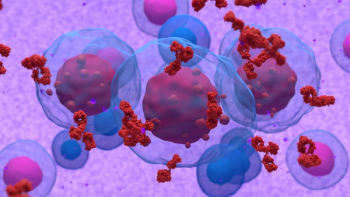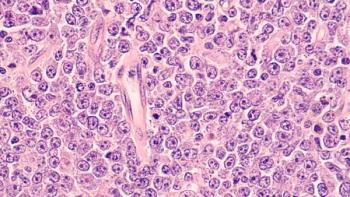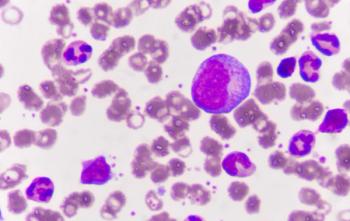
FDA OKs Companion Test for Telisotuzumab Vedotin in NSCLC
The VENTANA MET (SP44) RxDx Assay is now FDA approved to identify patients with NSCLC eligible for telisotuzumab vedotin.
The FDA has approved the VENTANA MET (SP44) RxDx Assay as a companion diagnostic to identify individuals with non–small cell lung cancer (NSCLC) and high c-Met protein overexpression who may be eligible for treatment with telisotuzumab vedotin-tllv (Emrelis).1
The VENTANA MET (SP44) RxDx Assay is an immunohistochemistry (IHC) assay designed to detect c-MET expression based on the percentage of tumor cells stained and the intensity of the staining.
On May 14, 2025, the FDA granted
“Understanding the molecular drivers in patients with NSCLC is critical for therapy selection,” Matt Sause, chief executive officer of Roche Diagnostics, stated in a news release.1 “By identifying MET protein expression at the appropriate stage in the patient journey, we can help provide timely, tailored treatment options that may improve patient outcomes and offer hope to those facing this challenging disease.”
The approval of telisotuzumab vedotin and the VENTANA MET (SP44) RxDx Assay were both based on findings from the phase 2 LUMINOSITY trial (NCT03539536), which evaluated the antibody-drug conjugate in patients with pretreated, advanced nonsquamous NSCLC with high c-MET expression.1,2
During the study, the MET (SP44) clinical trial assay was used to prospectively identify c-MET expression in screened patients.3 Among the 84 patients who underwent prospective evaluation for c-MET expression and enrolled on the study, 38 underwent retrospective evaluation using the VENTANA MET (SP44) RxDx Assay. One sample was unevaluable; among the 37 evaluable samples, 87% had high c-MET expression, defined as strong (IHC 3+) membrane and/or cytoplasmic staining on at least 50% of tumor cells.
Efficacy data from the study showed that patients with high c-MET protein overexpression treated with telisotuzumab vedotin (n = 84) experienced an overall response rate (ORR) of 35% (95% CI, 24%-46%), which were all partial responses.2,3 The median duration of response (DOR) was 7.2 months (95% CI, 4.2-12), and the 6- and 12-month DOR rates were 59% and 21%, respectively.
The open-label, single-arm LUMINOSITY trial enrolled patients at least 18 years of age with locally advanced or metastatic nonsquamous NSCLC harboring high c-MET overexpression per IHC testing.4 Patients also needed to have nonsquamous and EGFR wild-type disease. Notably, patients with other actionable mutations were allowed to enroll in part 1 if they had known EGFR wild-type disease; part 2 was limited to patients with nonsquamous, EGFR wild-type disease.
Patients needed to have disease progression following or intolerance to systemic cytotoxic therapy; immunotherapy with or without chemotherapy; and prior targeted anticancer therapies, if indicated. No more than 2 prior lines of systemic therapy—including 1 line of chemotherapy—were allowed in the locally advanced or metastatic setting; Notably, multiple lines of TKIs counted as 1 line of therapy.
All patients received telisotuzumab vedotin at 1.9 mg/kg once every 2 weeks.2,3 ORR and safety served as the trial's primary end points. Secondary end points included DOR, disease control rate, progression-free survival, and overall survival.3
Safety data from the study showed that the most common adverse effects reported in at least 20% of patients treated with telisotuzumab vedotin during LUMINOSITY included peripheral neuropathy, fatigue, decreased appetite, and peripheral edema.2 The most common grade 3/4 laboratory abnormalities occurring in at least 2% of patients consisted of decreased lymphocyte counts, increased glucose levels, increased alanine aminotransferase levels, increased gamma glutamyl transferase levels, decreased phosphorus levels, decreased sodium levels, decreased hemoglobin levels, and decreased calcium levels.
References
- Roche receives FDA approval for the VENTANA MET (SP44) RxDx Assay as the first companion diagnostic to identify non-squamous non-small cell lung cancer patients eligible for treatment with Emrelis. News release. Roche. May 13, 2025. Accessed May 15, 2025. https://www.roche.com/media/releases/med-cor-2025-05-14
- U.S. FDA approves Emrelis (telisotuzumab vedotin-tllv) for adults with previously treated advanced non-small cell lung cancer (NSCLC) with high c-Met protein overexpression. News release. AbbVie. May 14, 2025. Accessed May 15, 2025. https://news.abbvie.com/2025-05-14-U-S-FDA-Approves-EMRELIS-TM-telisotuzumab-vedotin-tllv-for-Adults-With-Previously-Treated-Advanced-Non-Small-Cell-Lung-Cancer-NSCLC-With-High-c-Met-Protein-Overexpression
- Emrelis. Prescribing information. AbbVie. May 2025. Accessed May 15, 2025. https://www.rxabbvie.com/pdf/emrelis_pi.pdf
- Study of telisotuzumab vedotin (ABBV-399) in participants with previously treated c-Met+ non-small cell lung cancer. ClinicalTrials.gov. Updated January 19, 2024. Accessed May 15, 2025. https://clinicaltrials.gov/study/NCT03539536
Newsletter
Knowledge is power. Don’t miss the most recent breakthroughs in cancer care.

















































































